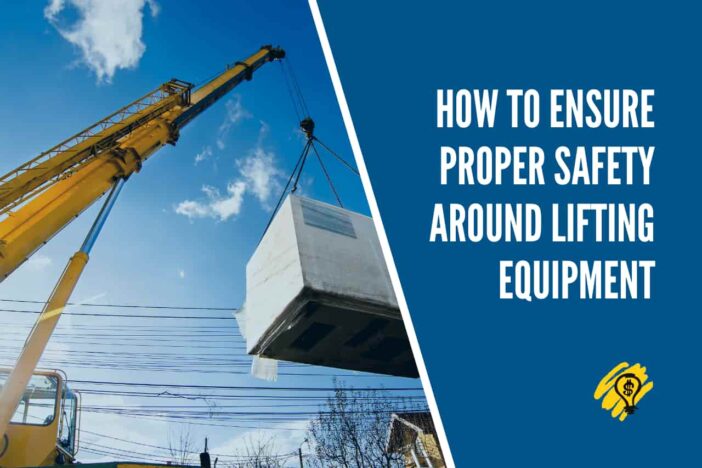Productivity is something that many business owners wish to have in their operations. It directly impacts the bottom line of most businesses, resulting in profits. In response to the critical need for tools to boost productivity, innovators created technology that facilitates work in labor-intensive industries such as construction. Lifting equipment is one of these productivity-enhancing technologies.
Forklifts, tower cranes, and hoists are all types of lifting equipment. Even though these machines have the potential to revolutionize the way people perform their jobs, they are not without risk. Lifting equipment is a crucial safety concern because you’ll be using it to carry heavy goods from one location to another. As a result, extreme care must be used when using lifting equipment to prevent damage from a burden of this magnitude from falling.
As a business owner looking to invest in lifting equipment, is there any way to protect the safety of your employees while using lifting equipment in your company? This article contains tips you can use; keep reading for more information.
Training Your Team
Adequate safety emanates from knowledge. Training is one sure way to prevent further safety issues in your plant. Therefore, you must train your workers regarding the importance of lifting equipment safely.
It is best to train the lifting equipment operators before educating all of the workers on your premises. Since they are in direct contact with the machinery, the rest of the team’s safety depends on them. It would be beneficial to seek the assistance of experts in the field to train your team, preferably where you procured your lifting equipment. They’re better equipped with the knowledge of their tools, unlike seeking general expertise.
Train the other workers in handling themselves around the lifting equipment. Consider conducting practice drills on what they should do in the event of an accident. The routine exercises will prepare them psychologically in the event of such an occurrence. In such a manner, they won’t be confused about what to do after an accident, preventing further damage and injuries.
Also, it’d help to hold the training regularly to keep your workers alert regarding their safety.
Related: How to Ensure a Safe and Smooth Heavy Equipment Transport
Providing Appropriate Safety Gear
When handling and operating lifting equipment, safety is of the utmost importance. You want to ensure the safety of all parties involved in the process, both directly and indirectly. Having the proper safety equipment is one sure way to accomplish this.
Make sure that all workers who are near the equipment are wearing helmets. The helmet will protect your head if any of the lifting equipment disassembles and falls. Since the part will fall from a great height, it will significantly impact wherever it lands. You don’t want this to be your worker’s head. Aside from the possibility of injury, it may result in lawsuits, which can deplete your financial resources.
Make sure the equipment operator is wearing the proper shoes and gloves. Hand gloves with a rough finish ensure the operator has a firm grip on the steering wheel and gear to avoid slipping. Slipping by accident could cause the equipment to change or cause a sudden movement during lifting, which can drop the lifted item.

Clearing Surrounding Area
You’ve most likely taken every precaution to avoid accidents and injuries when operating lifting equipment. However, even with all precautions, there is always the possibility of something going wrong. It’s best to be prepared for these scenarios. Clearing the area around the operating circumference of your lifting equipment is one preparation method.
To begin, remove any materials or storage boxes from your floors. Make sure no one is working near the lifting equipment while it is in use. Assign them to work on other plant sections until you’re finished lifting. Why should the area be cleared?
Your materials will not be damaged if a heavy load transported falls to the ground. Your employees will be safe as well, ensuring overall safety. Without these precautions, you risk damaging goods worth millions of dollars and injuring workers, resulting in lost productivity as they take sick leave to treat their injuries.
Schedule Regular Maintenance
Maintenance is one sure way to reduce, if not eliminate, worries about lifting equipment. Moreover, lifting equipment comprises many small and big components that enable it to function. It is best to inspect the machinery as part of routine maintenance. Check that all parts are intact and securely fastened; if necessary, tighten them to be sure. In addition, lubricating the moving parts is also part of maintenance.
Make a checklist of all the parts your team will need to inspect during maintenance checks. Also, schedule maintenance regularly, preferably monthly, and keep a record of all maintenance activities. The records will assist you in determining when it is time to replace a specific part, most likely due to constant replacement.
Regular maintenance keeps your lifting equipment in good working order and prevents malfunctions during operations, ensuring safety.
Conclusion
It is not difficult to ensure the safety of lifting equipment when utilizing it in your operations. You only need to implement the safety rules provided in the equipment’s manual and articles like this. By adopting them, it will be simple for you to enjoy the benefits of this technology.



